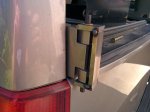There's always someone to rain on a parade, but when it comes to propane on the back of a vehicle...
See 5.2.3 listed below.
Lengthy but important. Quoting an old SMB forum reply of mine.
"Thanks to wadewaydo for the NFPA link.
I have spent a few eye watering hours going through the rules and have put a list together that reflects the regs I am interested in.
Feel free to use this list at your own risk.
NFPA 1192- 2018
The NFPA 1192 Standard on Recreational Vehicles 2018 is available for purchase or free online only viewing by signing up as a member and using the built in online viewer. Go here to start:
https://www.nfpa.org/codes-and...and-standards/detail?code=1192 Click on “Free Access” and follow it from there.
There are also older versions posted online in PDF form.
Here are the sections that most interested me in looking at propane regulations in an RV:
3.2.3 Labeled. Appliance marked by symbol of authority having jurisdiction over the unit.
3.2.4 Listed. Appliance included on a list by an authority having jurisdiction over the unit.
3.3.3 Appliance. Note difference between “heating appliance” and “heat-producing appliance”.
3.3.47 Propane container. Difference between DOT cylinder and ASME tank.
5.2.1 Maximum propane container capacities. Maximum of three 105 lb water capacity cylinders. One or more tanks with a maximum water capacity total of 200 gallons. (0.8 m3).
5.2.3 Location of propane containers. Where cylinders or tanks can be mounted. Not on the rear exterior or the rear bumper.
5.2.5 Heat shielding of propane containers and piping. Containers 18” minimum to heat-producing anything. Needs air gap baffle otherwise. Piping and hose 4.5” minimum or needs air gap baffle.
5.2.15 Regulators. Two stage needed to match maximum input of all appliances.
5.2.19 Pressure relief valve discharge distances.
5.3.1.4 Two stages of pressure regulation to appliances.
5.3.2.5 Propane piping specifications for material. (7) Type K or L meeting listed specification.
5.3.4 Propane pipe sizing tables. Match length and Btu loads to diameter required.
5.3.5 Joints for propane pipe. No left and right nipples or couplings. Specs on other methods.
5.3.6.1 Joints for propane tubing. Flare ends. No ball sleeve or internal compression fittings.
5.3.7 Pipe joint materials. Approved for propane. Male threads only.
5.3.8.1 Routing and protection of tubing and hose. Not to be run inside any concealed construction.
5.3.8.2 Tight fitting grommets where tubing or hose pass through walls. Heat and weather resistant.
5.3.8.3,4,5 Tubing or hose to be protected and unconcealed.
5.3.12 Connections. Regulators are not allowed to be directly attached to the shutoff valve of a cylinder.
5.3.18 Propane piping support. Various distances for piping support requirements.
5.4.1 Appliance must be listed.
5.4.2 Appliances except ranges and ovens must be vented to the outside.
5.4.6.4 Rules on RV manufacturer ensuring propane fridge will still vent properly after removal and re-installation.
5.5.2.1 Flue gas outlet from fuel burning heating appliances minimum 3 feet to motor driven air intake for living space.
5.5.3.1 Air inlet or flue gas outlet from fuel burning heating appliances minimum 3 feet from gasoline fuel filler spout. Annex A5.5.3 describes exclusion of diesel filler spouts.
5.6.6.5 Protection clearances for ranges with various burner ratings.
5.8.1 Warning labels and operating instructions required.
6.3.1, 6.3.2, 6.3.3 Smoke, carbon monoxide, and propane detector requirements.
6.4.2 Fire extinguisher requirements.
6.4.5 Internal combustion generators.
Table B.1 and Figure B.1 show typical propane supply system requirements.
Annex C shows product standard requirements.
Index is on page 56.
Most interesting or unexpected rule is that only fuel burning heaters have a minimum exhaust distance from fuel fillers and then only when the filler is for gasoline. Fridge doesn't count.
Essentially straightforward enough.
Oh, and no compression fittings in the propane line.
Cheers,
G."
Sent from my SM-G950W using Tapatalk

